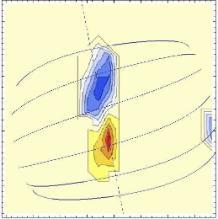Synthetic Aperture Microwave Imager (SAMI)
Contact people: Roddy Vann & Joe Allen (PhD student)

The Synthetic Aperture Microwave Imager (SAMI) is a novel diagnostic that captures 2-D images of the plasma surface, and by switching across its 16 frequency channels can scan in radius. It was installed on the UK's Mega-Amp Spherical Tokamak (MAST) in June 2011. At the scheduled conclusion of MAST operations, SAMI moved to the National Spherical Torus Experiment Upgrade (NSTX-U) at Princeton Plasma Physics Laboratory (PPPL) in the US. Rather like a synthetic aperture radio telescope, SAMI operates by measuring the phase difference between the signals that arrive at each pair-wise combination of its 8 antennas. SAMI captured the first ever 2-D images of BXO mode conversion from a tokamak plasma: understanding this process will be critical if RF heating is to be applied to an overdence spherical tokamak. SAMI has pioneered 2-D Doppler backscattering, which enables measurements of the magnetic pitch angle. In principle these measurements can be of sufficient spatial resolution so as to make independent measurements of the edge current density, which is not routinely measured by any other diagnostic and is a key parameter governing the stability of tokamak plasmas. Work is currently underway to enhance SAMI from a proof-of-principle device to a system capable of making production-quality measurements on MAST-U.
SAMI has been used for several purposes in addition to its original mission. A recent example (supported by the EUROfusion Enabling Research scheme) is the use of historical SAMI data to study microwave bursts during reconnection events including merging compression startup and edge-localised modes (ELMs). SAMI has shown that bursts during ELMs are spatially localised; the reasons for this are currently not fully understood.
